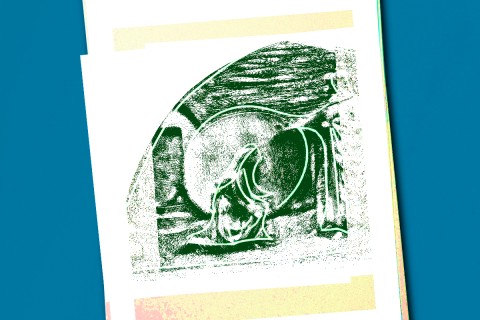January 13, Baptism C (Luke 3:15-17, 21-22; Acts 8:14-17)
About that baptism by fire
When I was growing up, my Baptist pastors referred frequently to Jesus’ full-immersion baptism in the Jordan River, but I don’t remember hearing much at all about the baptism of the Holy Spirit. I learned a bit about Spirit baptism when I visited a Pentecostal church during my college years. But I didn’t learn about baptism by fire until I left the Baptists for the Mennonites.
While it’s not discussed much in polite Mennonite conversation, baptism by fire is part of the church’s formal teaching. This is, of course, a faith group that traces its ancestry back to martyrs who were burned at the stake. Contemporary Mennonites are quick to point out that baptism by fire doesn’t require actual fire, or any other sort of gruesome death. It just means that you are theoretically willing to accept such a death, should it come to that.
The coming one, says John, “will baptize you with the Holy Spirit and with fire.” John doesn’t really explain what this means, but we can imagine where people later developed their understandings. In Acts, Jesus himself tells the disciples that they will soon be baptized by the Holy Spirit. Then Pentecost comes, accompanied by speaking in tongues (if not necessarily the kind most commonly practiced today). And I imagine that any of the faithful who witnessed a fellow believer burned at the stake couldn’t help but think of the promised baptism by fire.
I wonder, though, if these common understandings of baptism by the Spirit and by fire are quite what John the Baptist has in mind. Because his next line is this: “[The coming one’s] winnowing fork is in his hand, to clear his threshing floor and to gather the wheat into his granary; but the chaff he will burn with unquenchable fire.” This image of winnowing seems somehow connected to the baptism of Holy Spirit and fire. Fire is mentioned in both verses, and the Greek word for “spirit” can also mean “wind.” Anyone who has seen wheat thrown in the air and watched the chaff blow away will understand wind to be a vital part of the winnowing process.
Today we think of “separating the wheat from the chaff” as sorting out the good people from the bad. This understanding has always been unsettling to me. It’s the stuff of nightmares: a big, burly farmer-god throwing people into the air with a pitchfork, then burning alive the ones that come back down into the wrong pile.
But if the winnowing is in fact an image of baptism, as suggested by John’s words, then it becomes at once more comforting and more disturbing. Comforting because nobody is being hurtled in the air or completely destroyed by fire. Disturbing because we all are being shaken up and partially destroyed by fire.
Given John’s obsessive preaching about repentance and the way he connects winnowing with baptism, I suspect the baptism by Holy Spirit and fire is actually—or at least also—about separating the good from the bad within ourselves. The Messiah will take all the stuff of our lives and toss it up into the air, allowing the Spirit wind to blow away the parts that get in the way of who God wants us to be. The wheat will be gathered and the chaff will be burned.
Some of Jesus’ first followers would have preferred the traditional understanding of wheat and chaff, and they would have believed the wheat to be the Jewish people and the chaff to be the gentiles. In Acts, we see the early church’s progress toward becoming open to gentiles. It is the wind of the Spirit that leads them to this realization. Because while human beings might discriminate based on ethnicity, gender, social standing, or any number of other arbitrary criteria, at Pentecost it starts to become clear that the Spirit has no such prejudices. As the Jewish followers of Jesus saw the work of the Spirit blowing through the lives of gentile believers, they were forced to acknowledge that God was at work.
And so it is that in Acts 8, Peter and John—two apostles with impeccable Jewish credentials—travel to meet with newly baptized Samaritans. These believers have already received the water baptism. Peter and John pray that they might also receive the Holy Spirit. And the coming of the Spirit confirms the Samaritans’ place within the newly forming Christian community.
Immediately following the assigned reading, a man named Simon offers to pay Peter and John so that he, too, can have the power to give the Holy Spirit through the laying on of hands. The apostles harshly rebuke Simon, insisting that the Spirit is not something that can be sold or in any way controlled.
Perhaps this is why we talk so much more about water baptism than about the other sort of baptism. Even if we don’t agree on how much water to use or at what age to use it, we can form our opinions and develop our rituals and make the water baptisms happen more or less according to our design. But the baptism of the Holy Spirit and fire is something we cannot even understand, let alone control. What the Spirit does within us and among us is something we cannot contain—not in a small font, not in an immersion baptistery, not even in the Jordan River.





